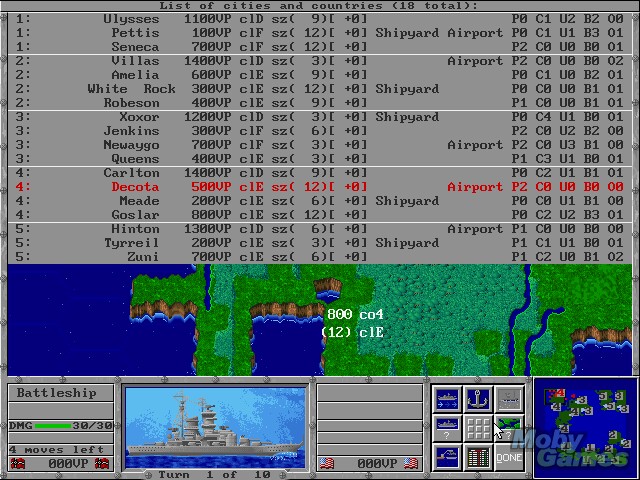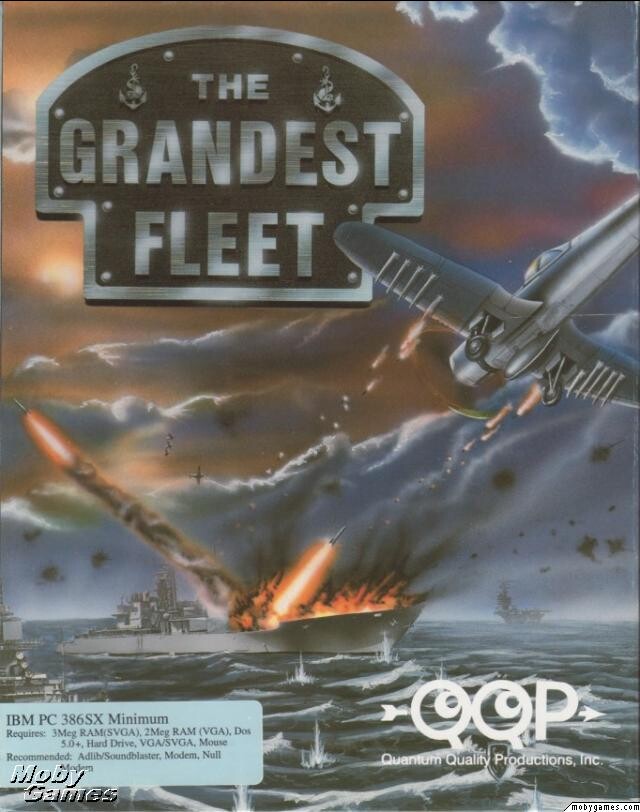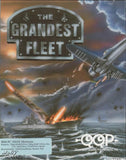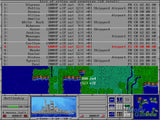
Actual Game
The Grandest Fleet1-Click Install
|
The Game
The Grandest Fleet is a successor to QQP's excellent The Lost Admiral. Very roughly equivalent to "Empire at Sea", you start with a set of ports and a set of naval units and set them off to battle. You can choose which units you start with, and your ports can produce more units over time.
The game keeps track of a set of 'officers'. When you play, you pick an officer to represent you, and your officer will get demoted/promoted based on your performance in the battle. In true QQP fashion, the game keeps abundant records of performance. This is not just chrome - you get a 'flagship' when you fight your battles, and the higher your officers rank, the more powerful your flagship.
You can fight one of three scenarios: either a 'historical' scenario, a randomly generated battle, or a 'campaign', which is essentially a series of linked battles.
Conceptaully, the game is rather like 'Empire at Sea'. You start with one (or more) cities, and explore and expand your way across the map. You get victory points each turn depending on how many cities you have. The game ends either after some number of turns (12, 20, or 32, or until annilhation). In each turn, you move your ships, and then enter a combat phase.
The turn length has a signficant impact on game play. In a 12 turn game the emphasis is on quickly grabbing ground, while in a 32 turn game there's more emphasis on developing and holding your currenti cities - a slower, more methodocal pace.
The game revolves around acquiring, holding, and developing the cities scattered around the map. In The Lost Admiral, cities were very simple entities, which could be conquered merely by moving a single unit into them. No longer! In Fleet, cities are much more important players. First of all, a la Civilization or Railroad Tycoon, cities can now have 'improvements'. Some of these may help directly in combat (a repair yard, for example), some of these grant you victory points (an opera house, for example), and some 'seed' the city so that it will grow more quickly (a 'downtown' or 'convoy', for example). Every turn you get a number of 'culture points' which you use to buy these improvements. The more cities you have, and the larger they are, the more culture they generate.
The cities, important as they are, are auxilliary to the ships, the main units in the game. The units are almost identical to those in The Lost Admiral, with only the addition of a 'minesweeper' and a 'light carrier', but some of them function in signficantly different ways.
First of all, unlike The Lost Admiral, units can now exert 'ranged' fire. While most units can fire only at adjacent enemy units, a cruiser can fire at units 2 away, a battleship at units 3 away, and an aircraft carrier at units up to 5 away. This was probably a result of another design change, namely that you can now only have one unit in a hex (in The Lost Admiral, you could have two).
Aircraft carriers, which were simple 'passive' creatures in The Lost Admiral, are much more realistically modeled in Fleet. They are now very powerful offensive weapons, as their planes pack quite a wallop. They are also very vulnerable, though - a measly 2 hits from most ships will sink them. Just as with bombers, their planes can get shot down, too - make sure you keep your carriers near a friendly airfield so their strength can get replenished. In a significant bug/feature, carrier planes can sink submerged subs, a major change from The Lost Admiral. Battleships have been dramatically enhanced. They are far less vulnerable to subs (they need 8 sub hits to be sunk, as opposed to 3 in The Lost Admiral), and their ranged fire and bombardment abilities make them probably the single most valuable unit in the game.
There's also an entire second set of ships, called 'super ships'. These are delux-o enhanced versions of the regular ships - a 'super battleship' is a real monster, a 'super transport' can invade almost anything, etc., etc. You can't buy these in initial setup, but can buy these during game play once you've developed your cities enough to enable them. I had mixed feelings about this whole 'super ship' business. On the one hand, once cities get big enough you really need super ships to take them. On the other hand, one of The Lost Admirals great strengths was its fine-tuned balance between unit types, which is now thrown out of whack by dumping in 5 more ship types, without, I think, enough thought given to their powers. The 'super transport', for example, is almost totally worthless as by the time it comes on the scene cities are typically armed with 'cruise missiles' which can sink it before it ever gets a chance to invade.
Each turn plays out in a very straightforward way. You move your units one by one. You see enemy units when they show up within the detection range of your units. This range can vary from 1 to 5, depending on the unit. After you've ended your movement, mutual simultaneous combat ensues - you are taken to each eligible unit, and select the enemy to fire on.
This is a pleasant game, particularly for fans of 'Empire' type simulations.






